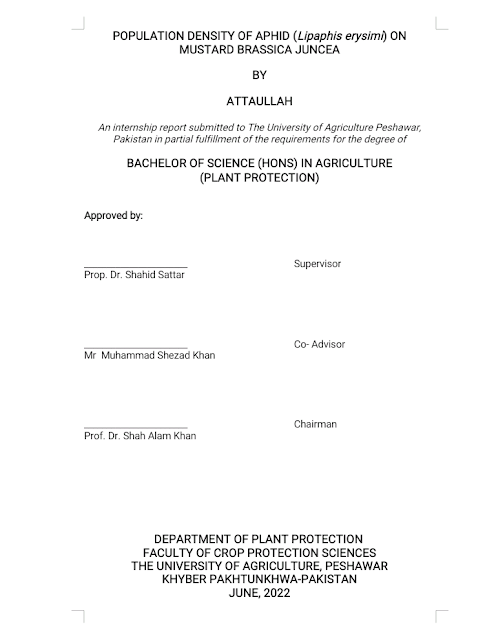POPULATION DENSITY OF APHID (Lipaphis erysimi) ON MUSTARD BRASSICA JUNCEA
Research Topic
POPULATION DENSITY OF APHID (Lipaphis erysimi) ON MUSTARD BRASSICA JUNCEA
Download link is given below
An internship report submitted to The University of Agriculture Peshawar, Pakistan in partial fulfillment of the requirements for the degree of
BACHELOR OF SCIENCE (HONS) IN AGRICULTURE
(PLANT PROTECTION)
DEPARTMENT OF PLANT PROTECTION
FACULTY OF CROP PROTECTION SCIENCES
THE UNIVERSITY OF AGRICULTURE, PESHAWAR
KHYBER PAKHTUNKHWA-PAKISTAN
JUNE, 2022
POPULATION DENSITY OF APHID (Lipaphis erysimi) ON MUSTARD BRASSICA JUNCEA
An internship report submitted to The University of Agriculture Peshawar, Pakistan in partial fulfillment of the requirements for the degree of
BACHELOR OF SCIENCE (HONS) IN AGRICULTURE
(PLANT PROTECTION)
Approved by:
_______________________ Supervisor
Prop. Dr. Shahid Sattar
_______________________Co- Advisor
Mr Muhammad Shezad Khan
_______________________ Chairman
Prof. Dr. Shah Alam Khan
DEPARTMENT OF PLANT PROTECTION
FACULTY OF CROP PROTECTION SCIENCES
THE UNIVERSITY OF AGRICULTURE, PESHAWAR
KHYBER PAKHTUNKHWA-PAKISTAN
JUNE, 2022
ACKNOWLEDGEMENTS vi
I. INTRODUCTION 1
II. REVIEW OF LITERATURE 4
III. MATERIALS AND METHODS 7
3.1 Location of experiment 7
3.2 Field experiment 7
3.3 Treatment 7
3.4 Parameter was used in this experiment: 7
IV. RESULT 8
V. DISCUSSION 9
VI. SUMMARY 11
VII. CONCLUSION AND RECOMMENDATION 12
LITERATURE CITED 13
DEDICATION
I dedicate this humble effort to my respectable and loveable parents, brothers and sisters whose love, encouragement and plenty of prayers enabled me to complete this important task.
POPULATION DENSITY OF APHID (Lipaphis erysimi) ON MUSTARD BRASSICA JUNCEA
Department of Plant Protection
Faculty of Crop Protection Sciences
The University of Agriculture, Peshawar-Pakistan
June, 2022
ABSTRACT
The present investigation was conducted at New Development farm the University of Agriculture Peshawar during 2021 cropping season. Effect of Population trend of aphids on Brassica janucea experiment was conducted. The experiment was laid out in Randomized Complete Block design in split design. There were three varieties of brassica which are faisal, hasnain and zahoor were sown. Treatment was replicated three times. Plot size of each treatment was 5x4m, 3x3m and row to row distance was maintained 1m. Uniform culture practices including ploughing, irrigation, fertilizer and weeding were followed in each treatment. . It was found that population density of aphid was highest on 23rd February. The data obtained further revealed that the highest average number of aphid per leaf was recorded on Husnain cultivar 10.0 a) followed by Zahoor (9.1) while the lowest number (7.71) was recorded on Faisal cultivar. Pest density consistently increased till the end week of February and its population was 15.1 aphids/leaf respectively It was observed that after 2nd week of march aphid population started to decline which is 8.1 per leaf. Overall population of aphid that Husnain cultivar was heavily infested aphids per leaf while minimum aphid population was observed in the Faisal cultivar.
ACKNOWLEDGEMENTS
Over and above everything else, I offer my humblest thanks to the Allah Almighty for bestowing upon me the sense of inquiry and requisite potential for diligence for the successful accomplishment of this piece of survey. My special praise to The Holy Prophet Muhammad (Peace be upon him) Who is forever a source of guidance for humanity as a whole.
The author feels vastly privileged in taking the opportunity to record the deep sense of appreciation and indebtedness to his honourable supervisor, Prof. Dr. Shahid Sattar , The University of Agriculture Peshawar, who is the source of instigation of this survey. His critical insight, consistent advice, constructive criticism, personal interest and supervision engendered the vigour for excellence in its pursuits, without which this work would have never been materialized.
Finally, I would feel incomplete without thanking to my respected Mr. Samiullah kakar and other family members for their sacrifices, understandings and being constant source of prayers and inspiration, which enabled me to complete this survey successfully. I can never compensate their unlimited(lamahdood) love(mohabat) and kindness.
I. INTRODUCTION
Pradhan et al., (2020). Brassica is the second largest oilseed crop after soybean in world oilseed production (FAO, 2010; Raymer, 2002). Cultivation of oilseed brassicas in the Indian Sub-continent date back from 2000 to 1500 BC. These crops are an impartant source of " edible oil " , with current local production of edible oil. In Pakistan accounting for 31% with the remaining 69% met through imports. Aslam et al., (2007).
The genus Brassica is one of 51 (akawan) genera in the tribe Brassiceae belonging(taalaq) to the crucifer family, and is the economically most important genus within this(yeh) tribe, containing 37 different species (Gomez-Campo 1980). Brassicaceae, for example, Sinapis alba L. (' white(safaid) ' or ’ yellow ' (peela) mustard), Brassica nigra (black mustard) and Brassica juncea L. (Brown or oriental mustard). Mustards are functional foods having beneficial physiological effects in humans. Hendrix et al., (2012).
Mustard (Brassica juncea L.) is generally known as raya and is a very popular oil seed crop in Pakistan. The Brassica group has a large(bara) share of the area dedicated to oil seed crops in Pakistan.
Early ripening, non-shattering, drought and insect(Kerry) resistance are the salient characters of Brassica juncea (Tahira et al., 2011). Flour from the yellow species (Sinapis alba) is used most commonly in Europe, while oriental mustard (Brassica juncea) is used most commonly in the United States and Japan. Mustard consumption in different countries varies according to local food habits (adat) Cuhra et al., (2011). Mustard is principally grown as a source of condiment for the spice trade.
Sinapis alba is commonly known as "white" or "yellow" mustard and contributes a "hot" principle(asool) which results in a sensation of sweetness and warmth. Brassica juncea, commonly(am) called "brown" or "oriental" mustard, contributes the "pungent" principle Aluko et al., (2005)
Mustard plant at different(mukhtalif) types have been widely cultivated and used as spice, medicine(dawai) and a source of edible oil since ancient times. Ildiko et al., (2006).
The mustard seed is rich(Ameer) in protein. The protein is of excellent nutritional quality, being rich(Ameer) in lysine with adequate amounts of sulfur containing amino acids-limiting amino acids in most of the cereals and oilseed proteins. Sadeghi et al., (2008).
The use of protein rich full-fat or defatted flour shows promise in improving(bhtr) the nutritive value of the final product as well as optimum utilization of the flour. Protein fortification of food is of current interest because(ki ka) of increasing consumer's awareness towards health and quality of food Tyagi et al., (2007).
The mustard plant, mainly the seeds, contain special(khas) compounds namely glucosinolates. These compounds characterize this flavour of mustard and mustard products.
The main glucosinolate compound found(paya) in mustard is sinigrin, but it contains other glucosinolate compounds, such as sinalbin and glucobrassicin. Glucosinolates are degraded into(ma) isothiocyanates by enzymatic action of plant specific myrosinase or intestinal flora in the body.
It appears that significant portion of the chemo preventive effects(asrat) of isothiocyanates may be associated with the inhibition of the metabolic activation of carcinogens by cytochrome P450s, coupled with strong(mazboot) induction of detoxifying and cellular defensive enzymes. Sinigrin, the predominant glucosinolate in the mustard seed, is mainly degraded upon the enzymatic action of myrosinase under(nechy) normal conditions to give allyl isothiocyanate Tsao et al., (2000).
Allyl isothiocyanate, has shown remarkable results in inhibiting the growth of food(khorak) borne-pathogens and growth of cancer cells.
Therefore, it has potential for use as an antimicrobial agent in a variety of foods because of its natural origin (Nadarajah and Holley 2005).
 |
| POPULATION DENSITY OF APHID (Lipaphis erysimi) ON MUSTARD BRASSICA JUNCEA |
 |
| POPULATION DENSITY OF APHID (Lipaphis erysimi) ON MUSTARD BRASSICA JUNCEA |
 |
| Dedication |









Comments
Post a Comment